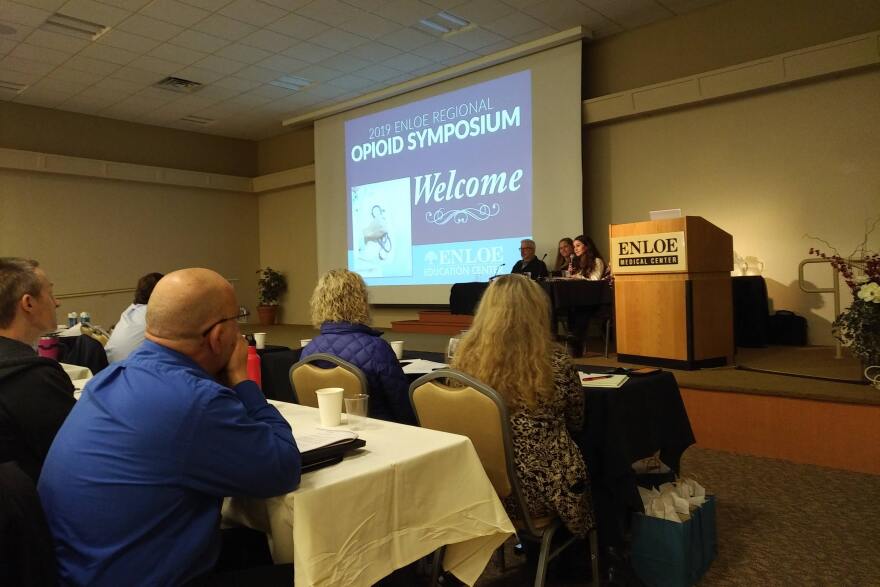Aiming to reduce painkiller-related addiction and deaths, doctors, nurses and other medical professionals met in Chico Friday to learn strategies to reduce dangers from opioids.
The full day event was aimed at medical professionals, not the general public. Experts presented information about alternative therapies, less addictive drugs and strategies, protocols both to wean people from opioids and reduce the likelihood of becoming dependent in the first place.
James Moore is an Emergency Room doctor at Enloe Medical Center and one of the speakers at the event. He laid out the size of the problem.
“We’re seeing more deaths related to opioid overdoses than car accidents, than suicides, than heart attacks. I mean, this is really a health issue. This is a disease that needs to be treated like any other chronic disease.” Moore said.
Opioid medications, derived originally from opium poppies, have been around for more than a century, under dozens of names. Some people are more genetically predisposed to becoming dependent or addicted than others.
Codeine, Lortab, hydrocodone, Oxycodone, Percocet, morphine, Dilaudid and Heroin are just a few, mainly brand names for different strengths and combinations.
Dr. Andrew Miller, Public Health Officer for Butte County, and a presenter at the conference said that the stage was set several decades ago for the addiction epidemic.
“There was the incorrect belief that if you gave people opioids for pain, if they really had pain, they were not addictive and there were few downsides. That was incorrect.” Miller said.
Reporter asked “That was really the pharmaceutical marketing?”
To which Miller replied, “That was ahh, Pharmaceutical marketing and the fact that it made it convenient to do something that was easy.”
Miller also said policies prioritizing pain treatment and medical ratings based in part on patient satisfaction contributed to the spread.
In addressing growing addiction rates, government regulators along with the medical industry started making opioids more difficult to come by. It didn’t solve all of the problems. Especially for those dependent.
“If you take away prescription medications, people that don’t have other alternatives are going to find those pills on the street, or even worse, they’re going to start getting like, heroin, which is much stronger, that’s when you really start seeing people dying.” Moore explained
That’s not to say that there aren’t very legitimate uses for the medication.
“Don’t get me wrong, sometimes you need strong narcotics to treat pain, but the idea is, you should not be on those medications any longer than you need to be.” Moore said.
To begin turning the tide, experts had several strategies. Obviously, prescribe them only when really necessary, and in limited quantities—so extra pills don’t end up on a shelf. One presenter said it was fairly typical for some young people to have their first experiences with opioids by exploring the medicine cabinet at home. Alternative therapies, including physical therapy or steroid injections when appropriate are among other options.
“There are alternatives in treatment, increasingly being used for chronic pain such as Bupinorphine, so, we talked a lot about bupinorphine today or suboxone.” Moore said.
Both are in a class of opioids that dull pain, but create no euphoric effect---and therefore supposedly not addictive.
Moore said ultimately, the responsibility rests with physicians.
“A doctor’s responsibility to their patients is to think about these things. When is it appropriate to prescribe pain medicines, but more importantly, when is it appropriate to stop the pain medicine, and I think that’s where the difficult part lies because a patient who’s dependent is maybe never going to say ‘no,’ right? But that’s why you’re the doctor, right? That’s why you’re the one writing your name on that script to do the responsible thing, even if the patient may still have some pain. I think it’s no coincidence that the US is 5 percent of the world’s population, though we consume 80 percent of all the world’s narcotics for pain control.” he said.
According to county health officials, while California as a whole has fewer deaths per capita from prescription opioids than three quarters of other states, the death rates in many rural counties in California are comparable with rates in states where the problem is biggest.


